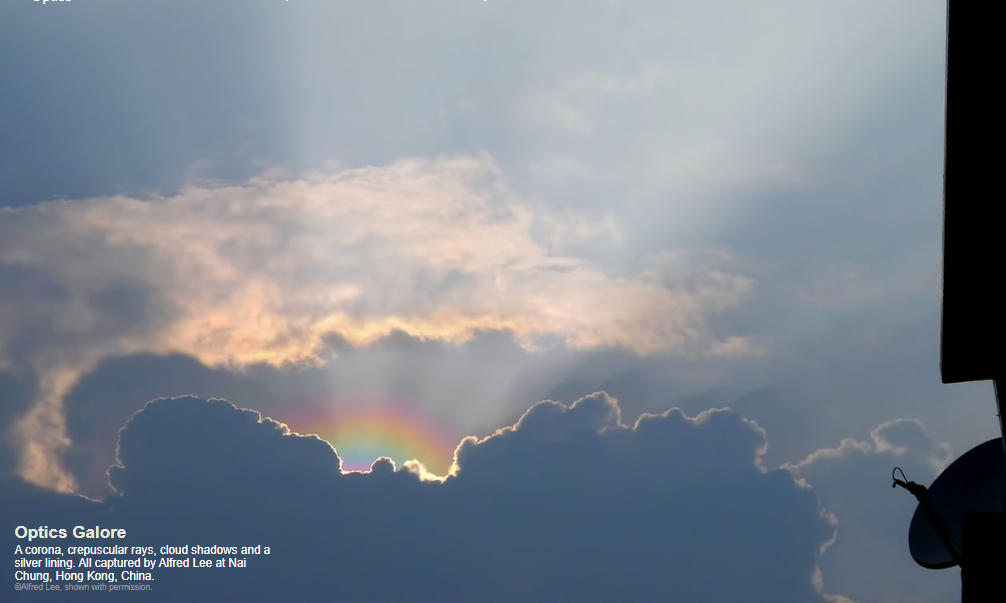OPOD - Optics Galore
OPOD - Optics Galore: A Fascinating World of Atmospheric Phenomena
The world above us is a canvas of awe-inspiring atmospheric optics phenomena. From corona and crepuscular rays to cloud shadows and silver linings, the sky offers a captivating spectacle for those who take the time to observe. In this article, we will delve deeper into the intricacies of these optical wonders, shedding light on their formation and characteristics.
The Mysterious Corona
One of the most enchanting sights in the sky is the corona, a shimmering halo of colors encircling the Sun or Moon. It is created by water droplets in the atmosphere, but the exact source of these droplets remains uncertain. While pileus clouds can contribute to the vivid iridescence or fragmented appearance of a corona, they are not evident in the captured image. However, faint iridescence can be observed along the upper edge of the cumulus cloud, adding an ethereal touch to the scene.
Unraveling the Secrets of Cloud Shadows
Have you ever noticed sun rays seemingly radiating upwards from a thunder cloud? These intriguing shadow tubes are actually formed by the cloud itself. The dark zone surrounding the thunder cloud represents its two-dimensional shadow cast onto a lower layer of clouds. This phenomenon showcases the dynamic interplay between light and cloud formations, painting the sky with captivating patterns.
The Silver Lining: Illuminating Cumulus Clouds
While not every cloud has a silver lining, cumulus clouds often do when viewed against the light. When a cloud is thin, such as at its edge, sunlight is scattered primarily by one or two encounters with droplets. This forward scattering creates a radiant "silver" rim that adds a touch of brilliance to the cloud's appearance. However, as sunlight penetrates deeper into the cloud, it scatters multiple times, loses its directionality, and is progressively absorbed. Consequently, clouds viewed contre jour appear darker, yet they still possess a mesmerizing play of light and surprising colors.
Sundogs: A Glimpse of the Halo Phenomenon
Tsim Sha Tsui in Hong Kong offers a glimpse into the world of sundogs, also known as 22° halos. These beautiful fragments of a halo can be observed around the Sun, forming a circular arc at approximately 22 degrees. Sundogs occur when sunlight refracts through ice crystals suspended in the atmosphere, creating a stunning display of light and color. The intricate interplay between light and ice crystals produces this remarkable optical phenomenon, captivating those fortunate enough to witness it.
Delving Deeper into the World of Atmospheric Optics
The captivating images shared in this article offer only a glimpse into the vast array of atmospheric optics phenomena that grace our skies. From the mysterious corona to the enchanting play of light in cumulus clouds, the world above us is a treasure trove waiting to be explored. By taking the time to observe and appreciate these natural wonders, we gain a deeper understanding of the intricate workings of our atmosphere and the beauty that surrounds us.
In conclusion, the sky is not just a vast expanse above us; it is a theater of optical wonders. Each cloud, each ray of sunlight, and each water droplet contributes to a symphony of colors and patterns that captivate our imagination. So, next time you find yourself gazing at the sky, take a moment to appreciate the intricate dance of light and atmosphere unfolding before your eyes. The world of atmospheric optics is waiting to be discovered, offering endless fascination for those who dare to look up.

Optics Galore
A corona, crepuscular rays, cloud shadows and a silver lining. All captured by Alfred Lee at Nai Chung, Hong Kong, China.
©Alfred Lee, shown with permission.

The corona is formed by almost uniform sized water droplets. Their source is uncertain. Pileus forming above rising cumulus gives vivid iridescence or corona fragments but its characteristic 'cap' shape is not evident here. Note however the faint iridescence elsewhere on the upper edge of the cumulus.
The sun rays apparently radiating upwards are downward going 3D shadow tubes formed by the thunder cloud. The dark zone around the thunder cloud is, however, its 2D shadow cast onto a lower cloud layer.
Every cloud does not have a silver lining. But most cumulus clouds do when viewed against the light. Where a cloud is thin � as at its edge � sunlight is scattered mostly by one or two encounters with droplets. The light is scattered mostly in the forward direction and forms the �silver� rim. Sunlight penetrating deeper into the cloud is scattered many times and loses its directionality. It is also progressively absorbed and thus clouds viewed contre jour are dark. Nonetheless they do show some light and often with surprising colours.

A sundog or 22° halo fragment at Tsim Sha Tsui, Hong Kong.
Note: this article has been automatically converted from the old site and may not appear as intended. You can find the original article here.
Reference Atmospheric Optics
If you use any of the definitions, information, or data presented on Atmospheric Optics, please copy the link or reference below to properly credit us as the reference source. Thank you!
-
<a href="https://atoptics.co.uk/blog/opod-optics-galore/">OPOD - Optics Galore</a>
-
"OPOD - Optics Galore". Atmospheric Optics. Accessed on April 19, 2024. https://atoptics.co.uk/blog/opod-optics-galore/.
-
"OPOD - Optics Galore". Atmospheric Optics, https://atoptics.co.uk/blog/opod-optics-galore/. Accessed 19 April, 2024
-
OPOD - Optics Galore. Atmospheric Optics. Retrieved from https://atoptics.co.uk/blog/opod-optics-galore/.